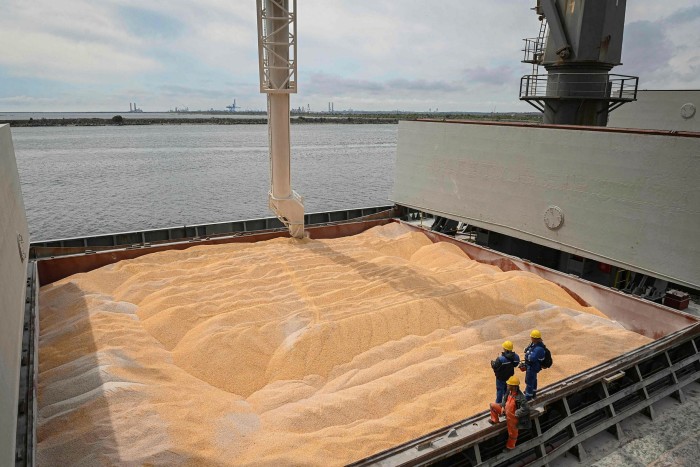Military briefing: Ukraine seeks way to break Russia’s Black Sea blockade
The sky above the Ukrainian city of Lviv lit up in the early hours of Tuesday after a volley of precision missiles fired from Russian vessels in the Black Sea destroyed a nearby weapons depot.
The strikes, just 40km from the Polish border, were an explosive reminder of the threat posed by Russia’s naval forces despite the high-profile loss of the cruiser Moskva, flagship of its Black Sea fleet.
Russia’s navy has had a more successful conflict than Vladimir Putin’s land forces, which failed in their initial aim to seize control of Ukraine’s biggest cities. By contrast Russia’s navy moved quickly to close off the Sea of Azov and establish control of the Black Sea, sealing off other shipping traffic and giving it a platform from which to launch hundreds of strikes on Ukraine.

This has allowed Moscow to exert a naval blockade that has all but halted Ukrainian grain exports, suffocating its main export industry and driving global food prices to record highs. Military strategists call this “sea blindness” — the inability to see the crucial role that naval power plays in a country’s security and economy.
An estimated 20m tonnes of grain are stuck inside Ukraine, which could ease pressure on global markets if it was released. Ukraine president Volodymyr Zelensky has described the situation as “frightening” while the UN World Food Programme’s David Beasley has been more explicit. “Millions of people will die because these ports are blocked,” he warned last month.
“The blockade is something of a ticking time bomb for the world,” said Sidharth Kaushal, a research fellow at the Royal United Services Institute think-tank in London. “And because the rest of the war on land is in stalemate, time is on the blockaders’ side.”
Over 90 per cent of Ukraine’s grain and oilseed exports left by ship before Russia’s full-blown invasion in February, at a rate of up to 6m tonnes per month. Now about 80 of the world’s merchant ships are stuck in Ukrainian ports while at least 10 have been hit or attacked since Russia launched its assault, according to the International Maritime Organization.
The cost of marine insurance in the Black Sea has soared as a result. Mines that Ukraine placed in the waters near Odesa and other ports are another problem, as removing them could allow Russia to launch amphibious attacks. Other mines have come adrift from seabed cables. Russia has also laid mines.

Ukrainian officials and their western counterparts are now casting around for a solution — not least as Russia’s blockade gives Moscow a powerful bargaining chip against western sanctions.
Rail is an alternative, with the EU setting out a plan to help Ukraine export 20m tonnes of grain over the next three months. But there are severe bottlenecks at the borders, as Ukraine’s EU neighbours use different rail gauges. Road freight is hampered by shortages of trucks, drivers, fuel and customs officials.
Escorted naval convoys are another possibility, but Ukraine’s navy is tiny and cannot do the job itself.
Ukraine lost most of its fleet when Moscow secured its naval base at Sevastopol in 2014 with the annexation of Crimea, and its sole frigate and flagship was scuttled in February to prevent Russian capture.
By contrast, Russia has four submarines in the Black Sea armed with Kalibr cruise missiles. It also has two modern frigates, several smaller warships and multiple missile boats and landing ships, according to HI Sutton, a naval expert who runs the maritime open-source intelligence outlet Covert Shores.
Andriy Zagorodnyuk, a former Ukrainian defence minister who advises the government, has suggested “a protected marine zone” enforced by western naval power. V. Group, the world’s largest ship manager, has urged Nato to provide naval escorts for commercial ships.

Similar mechanisms have been used before, such as the UN-mandated naval escorts that have protected merchant vessels from pirate attack off Somalia.
But Black Sea convoys would face greater problems, analysts say. For one the Montreux convention, which regulates shipping through the Turkish straits, limits warships from non-littoral states to being in the Black Sea to no more than 21 days
“To maintain a functional convoy system, you’d have to have a huge western fleet stationed in the Mediterranean to rotate through the Black Sea,” said Kaushal.
Even if that worked, there is the risk of escalatory confrontation with Russian warships, a debate that recalls many of the arguments about whether Nato allies should establish “no-fly zones” over Ukraine.
“How many countries would want to risk their ships going cheek by jowl with the Russian navy?” Kaushal added.
Meanwhile, the food problem is likely to get worse. One western official said “there are discussions, hopefully UN supported . . . about who could enable those convoys”. But another warned that enabling access to Ukrainian ports, while a theoretical option, was “not a practical one for the next six months”.
That may be too late as Ukraine’s storage facilities are too full to take in its summer harvest. Dmytro Kuleba, Ukraine’s foreign minister, called it a “super problem”, while also insisting there was “a military solution to this: defeat Russia”.
Destroying, even partially, Russia’s Black Sea fleet may seem a tall order. “The question is if Ukrainian military ingenuity on land can be repeated at sea,” said one western defence adviser, adding that military aid to Ukraine now includes Norwegian anti-ship Penguin missiles.
Russia’s diesel-powered submarines also have to resurface regularly, which makes them vulnerable to attack, the official added. Destroying the Kerch Strait Bridge that Russia uses to supply Crimea could also leave Putin’s forces struggling with the same kinds of logistical problems it has faced elsewhere.
“If we receive even more military support, we’ll be able to throw them back . . . defeat the Black Sea fleet and unblock the passage for vessels,” Kuleba said.
